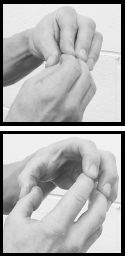
Main muscles worked
finger extensors
Capsule description
against resistance, open all the digits of the hand
The finger extension is an important exercise. It strengthens the muscles that extend the fingers, whereas exercises that involve the grip work the muscles that flex the fingers. A strength imbalance between these opposing muscles can cause elbow problems.
Manual resistance

Put the digits of your right hand together. Put the tips of the fingers (and thumb) of your left hand on the outside ends of the corresponding digits of the other hand. Open your right hand against resistance provided by your left hand. Allow the finger joints to bend sufficiently to produce a full range of movement.
Once you’re working the exercise hard, following a period of gradual adaptation, perform a warm-up set for each hand with minimal resistance. Then perform the work sets with enough resistance to make each rep taxing. Apply resistance against the fingers as they open and close—positive phase and negative phase, respectively. Provide more resistance during the negative phase. Perform each rep smoothly, over a full range of motion.
Another method, while seated, is to place the tips of your right hand together, and put your hand between your lower thighs, with your wrist turned so that your right thumb is against your right inner thigh. Keep all your digits straight, and spread the load evenly over all of them. Find the precise positioning of your hand that permits this. Perform each rep smoothly, over a full range of motion, with enough resistance from your thighs to make each rep taxing on the positive and negative phases.

Thigh-assisted, manual finger extension. Try with feet together, and feet hip-width apart. The latter may enable you to apply resistance with greater control.
The manual finger extension doesn’t permit measurable resistance. Over time, however, gradually increase the manual resistance.
Band resistance

For measurable resistance, get some elastic bands that are about three inches or eight centimeters long when not stretched. Take just one of them, to learn the exercise. Put all five digits of your right hand inside the elastic band so that the band rests approximately on the joints nearest your finger nails. Smoothly stretch out your fingers as far as you can without the elastic band slipping down. Find the degree of curvature in your fingers needed to keep the elastic band in place throughout the exercise.
Find elastic bands of various strengths so that you can add gradual resistance. Regularly replace the bands because, with use, they lose strength and elasticity.
To help keep the bands in position, twist them around your middle finger before putting your other digits inside the bands. This will increase the tension on the bands and reduce the number of them you can use, unless you switch to longer bands.
The Metolius “GripSaver Plus” is a ready-made device for finger extension, designed specifically for rehab or prevention of climbing-related finger, wrist, and elbow injuries. It’s an alternative to elastic bands, although it doesn’t provide variable resistance.